Psoriasis (Übersicht) Images
Go to article Psoriasis (Übersicht)



Psoriasis capitis: chronically inpatient red plaques extending beyond the hairline with discrete scaling (caused by pre-treatment). occasional itching


Psoriais capillitium: largely untreated psoriasis of the capillitium



Psoriasis of the ear: chronically inpatient, flat whitish scaly plaques (no pre-treatment) in long-term psoriasis. 27-year-old patient.
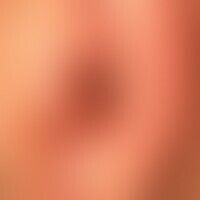


Psorisis, plaque type: chronic relapsing-active psoriasis with larger, in places confluent plaques, as well as smaller fresh papules and plaques.

Chronic in-patient plaque psoriasis: chronic in-patient psoriasis; for months in a constant location without significant relapse activity.

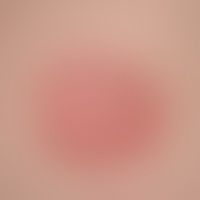
Psoriasis: non-pretreated psoriatic plaque, sharply defined, coarsened surface relief.
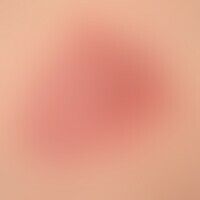
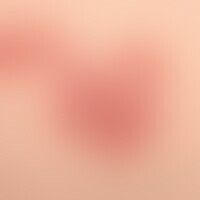
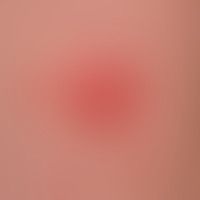
Psoriasis: moderately pre-treated psoriatic plaque, sharply defined, coarsened surface relief.

Psorisis, plaque type: chronic relapsing-remitting psoriasis with larger, in places confluent plaques, as well as smaller fresh papules and plaques.

Psorisis, plaque type: chronic relapsing-active psoriasis with larger, in places confluent plaques, as well as smaller fresh papules and plaques. Largely symmetrical infestation pattern.

Psoriasis: pre-treated psoriatic plaques and papules (relapsing-active psoriasis). The textbook described scaling is missing (caused by pre-treatment). However, this is rather the normal finding nowadays.

Relapsing activity in chronic psoriasis: psoriasis known for a long time. 4 weeks (post-infection) of clear relapsing activity with small papules and plaques. Itching.

Psoriasis: relapsing-active psoriasis with appearance of psoriatic lesions in "textile-covered" skin areas.


Relapsing activity in chronic psoriasis: psoriasis known for a long time. 4 weeks (post-infection) of clear relapsing activity with small papules and plaques. Itching.

Psoriasis: Plaque type with anular formations. Massive scaling. No pre-treatment.


Psoriasis: Gutta type with acutely opened, small-focus formations, weeping scale superimpositions in the area of the periumbilical plaques.
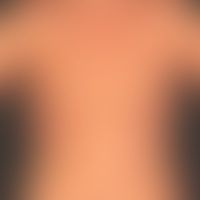
Psoriasis anularis: chronically active psoriasis vulgaris with anular psoriatic plaques, no pustular formation.


Psoriasis vulgaris chronic active plaque type: previously known pysoriasis; now sudden relapse activity with multiple disseminated, small psoriatic lesions as a sign of "relapse activity".
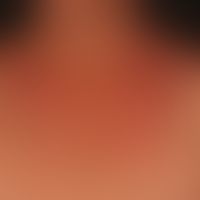
Psoriasis seborrhoeic type: Psoriasis with sharply defined, edge-emphasized, flat, hardly elevated, therapy-resistant, scaly plaques.

Psoriais pustulosa generalisata: pustular exanthema that develops within a few weeks in patients with known psoriasis; the figure shows a state already in the process of healing with a racy flake detachment

Psoriasis guttata. 0.1-2.0 cm in size, reddish, rough papules and plaques with fine-lamellar scaling on the trunk and extremities in a 24-year-old woman, acutely and de novo. This was preceded by a feverish streptococcal angina. After the first manifestations had healed, the psoriasis then developed into a chronic, intermittent course over many years.

Chronic inpatient psoriasis: typical infestation pattern.

Chronically active psoriasis: typical pattern of infection; psoriatic plaques with little visible scaling; caused by pre-treatment

Psoriasis inversa: massively infiltrated, sharply defined, red plaques with borky scale deposits.
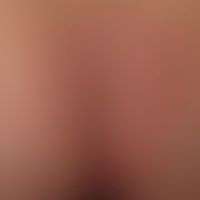
Psoriasis with pronounced affection of the buttocks region. The symmetrical affection of the buttocks region can be seen as Köbner phenomenon. Circumscribed a previously known keratosis follicularis.

Psoriasis: Extensive, untreated plaque psoriasis, in addition to larger, in places confluent plaques, smaller papules and plaques as a sign of shear activity.


Psoriatic nail psoriasis: characteristic features of psoriatic onychopathy with spots, oil stains and psoriatic onycholysis (see also psoriasis of the nail).


Nail psoriasis: massive psoriatic onychodystrophy with complete crumbly destruction of the nail plate (so-called psoriatic crumb nail).

Nail psoriasis: unspecific nail dystrophy (which is also found in this way in chronic hand dermatitis), caused by paronychial infestation of the thumbs.


Psoriasis palmaris: chronic in-patient plaque psoriasis of the hands with localized keratotic plaques, sometimes in stripes; Dupuytren's contracture grade 2.

Psoriasis palmaris: chronic inpatient plaque psoriasis of the hands with localized, in places striped, keratotic plaques that have been present for years.

Psoriasis palmaris: pustular/dsyhidrotic form.

Psoriasis palmaris: chronic, in-patient plaque psoriasis of the hands that has been present for years; increasing spread of hyperkeratosis with glove-like, extensive infestation (DD Keratosis palmoplantarisdiffusa circumscripta -Unna-Thost as a result of amutation of the KRT9/1 gene)

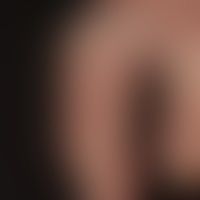


Psoriasis of the hands: here partial manifestation in the context of generalized psoriasis.

Psoriasis of the hands: here partial manifestation in the context of generalized psoriasis, the acral affection led to psoriatic onychodystrophies.

Psoriasis of the hands: here partial manifestation in the context of generalized psoriasis. No preexisting conditions. The acral affection led to massive psoriatic onychodystrophies (crumb nails).

Psoriasis of the hands: here partial manifestation in the context of generalized psoriasis. No preexisting conditions. The acral affection led to massive psoriatic onychodystrophies.

Psoriasis: chronic psoriasis plantaris with extensive infestation of the forefoot and big toe.


Psoriasis of the feet: here partial manifestation in the context of generalised psoriasis.

Psoriasis of the feet: here partial manifestation in the context of generalised psoriasis.

Psoriasis of the feet: here partial manifestation in the context of generalised psoriasis.

psoriasis: here partial manifestation of a generalised psoriasis. plaques, papules, papulo-pustules. massive, in places weeping scale overlays. no pre-treatment.

Psoriasis of the feet: here partial manifestation in the context of generalised psoriasis.
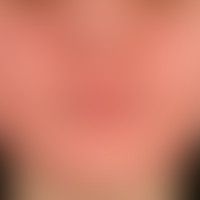
Psoriasis seborrheic type: Psoriasis with little sharply defined, flat, barely elevated, therapy-resistant, scaly plaques.



Psoriasis: Mosaic dermatosis with expression of psoriatic plaques in the Blaschko lines (right shoulder in band-shaped pattern) and on the right half of the back as a so-called pyhloid pattern (see following schematic pattern).

Cutaneous mosaic patterns (after Peter O. Fritsch, 1998): Type 1a: Blaschko lines in narrow bands, Type 1b: Blaschko lines in wide bands, Type 2: checkerboard pattern, Type 3: phylloid pattern; Type 4: large patches without centerline separation, Type 5: lateralization

Psoriasis: psoriatic minus variant of the lips (psoriasis is detected by typical psoriatic plaques on the elbows and knees); discrete foci on the upper lip marked by arrows and a circle.


Psoriasis inversa, minus variant: discrete psoriatic affection of the axilla.



